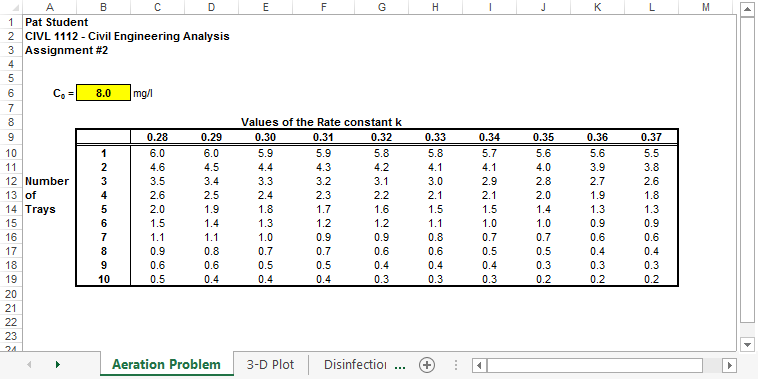|
"I am always ready to learn, but I do not always like
being taught." Winston Churchill
You must hand in the cover
sheet for the assignment, your calculations
for Parts 1 and 3, and printouts of your
spreadsheets for Parts 2 and 3. Also, submit
your spreadsheets for Parts 2 and 3 to Canvas.
You must follow the
Excel format.
Part
1: Solve the following three
problems (you are not required to use an Excel spreadsheet)
Carbon Dioxide Removal #1
-
Groundwater containing 30 mg/l of carbon dioxide
will be degasified using a multiple-tray aerator with six trays. In
this water treatment facility, ten aerators operate in parallel. For
maintenance reasons, only nine aerators are available at
any time. The design population is 50,000, and the maximum day demand is
150
gal/person-day. The k value is 0.33, and the hydraulic loading is
3
gpm/ft2. Determine:
The carbon dioxide content of the product water.
The size of the trays if the length-to-width ratio is
2:1 and the trays are made in 1-inch increments.
Carbon Dioxide Removal #2
-
Groundwater containing 25 mg/l of carbon dioxide
will be degasified using a multiple-tray aerator. The design
population is 250,000, and the maximum day demand is 150 gal/person-day. The
k
value is 0.32, and the hydraulic loading is 4 gpm/ft2. Determine:
Determine the total number of trays in an aerator
required to reduce the product water's carbon dioxide content by 90%.
Determine the number of aerators, operated in
parallel, required for the water treatment facility if each tray's size is 1,000 ft2.
Disinfection
|
Time,
seconds |
1 |
2 |
4 |
8 |
|
N/N0
|
4,270/10,000 |
1,830/10,000 |
332/10,000 |
11/10,000 |
Note: A solution to the problems in Part
One will be available after the
due date.
Part 2: Use Excel to develop a table containing the carbon dioxide
removal in a water treatment process using
the aeration model we described in class.

Develop a spreadsheet where the number of aeration trays, n,
varies with the row, and the rate constant, k, varies with the
column. Also, allow the initial effluent concentration to be a parameter in your
calculations. In other words, store the value of C0
in a cell outside the table.
Click here
for an Excel template spreadsheet for this problem. Your name should appear at the top left,
and the assignment number and date should appear at the top right.

The calculation of the carbon dioxide during aeration involves the use of the Excel EXP()
Function.
When copying your information into the table, be very careful with your
cell references (relative and absolute cell referencing). Pay special attention to which parameters vary
along the row and which vary along the column.
Part 3: Use Excel to
demonstrate the effects of coagulant on effluent turbidity (NTU) as recorded in
the lab.
-
From the jar test
data, plot the supernatant turbidity (NTU) as a function of the coagulant
dosage. Click
here for jar test data.
-
Determine the best dosage of coagulant from your
observations and measurements.
-
Using the dosage found in Part b, calculate the quantity
(lb.) of the coagulant needed to treat 20 million gallons per day (MGD).
Part 4. Read Chapters 3 and 4 in "A Mind for
Numbers" by Barbara Oakley.
A web page describing the CIVL 1112
Excel Homework
Policy is available. Please read it before you turn in each assignment this semester. You
will be graded according to the policy outlined in it.
Cover sheet for homework
This website was originally
developed by
Charles Camp for
CIVL
1112.
This site is maintained by the
Department of Civil Engineering
at the University of Memphis.
Your comments and questions are welcomed.
|



